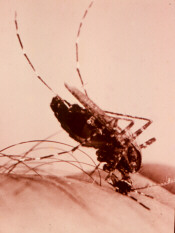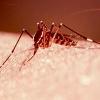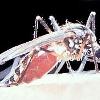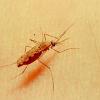Lymphatic Filariasis

Adult Mansonia mosquito. US Navy Disease Vectory Ecology and Control Center.
An infection of the human lymphatic system by filarial nematodes (round worms) vectored
by mosquitoes. Classified into two groups, Bancroftian (Wuchereria bancrofti) and Malayan (Brugia malayi and B. timori), these three filarial parasites affect over 120 million people in 73 endemic countries
world-wide located primarily throughout tropical and subtropical regions of South
America, Asia, the Pacific Islands and Africa. Although designated by the World Health
Organization (WHO) as the world’s second leading cause of permanent and long-term
disability, this mosquito-borne disease is "potentially eradicable" through drug therapy
and vector control.
Humans serve as the reservoir for this disease. Mosquitoes taking a blood meal ingest
microfilaria (larval stage) which are present in the blood. In the mosquito, ingested
microfilaria penetrate the stomach wall, develop in the thoracic muscles and eventually
migrate to the proboscis. The mosquito becomes infective about 12-14 days following
a blood meal. When the mosquito feeds again, the larvae emerge and enter the skin
through the bite, traveling to the lymphatic system where development to the adult
stage (macrofilaria) takes place over a period of 3-15 months. Once reaching sexual
maturity, adult nematodes produce microfilaria which migrate to the blood.
Filarial nematode activity in humans may result in the following symptoms: acute fever,
lymphadenitis, hydrocele (enlargement of the scrotum), elephantiasis of the limbs
and breasts, and a bronchial-asthmatic condition known as tropical pulmonary eosinophilia.
Although often debilitating, filariasis is rarely fatal. However, secondary bacterial
infection of the skin is often characteristic of elephantiasis and may result in death
if not treated.
There are many mosquito species which act as vectors for the three different species
of filarial nematodes. For example, 9 species of Anopheles vector filariasis in tropical
Africa alone. Specifically, the most important vectors of W. bancrofti are Culex quinquefasciatus, Anopheles gambiae, An.funestus, Aedes polynesiensis, Ae. scapularis and Ae. pseudoscutellaris. B. malayi is vectored by An. barbirostris, An. sinensis, An. donaldi and several species of Aedes and Mansonia. Finally, B.timori is transmitted by An. barbiostris.
Information Source
- US Navy Disease Vector Ecology and Control Center, Jacksonville, FL.



